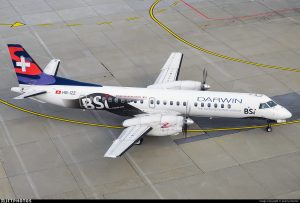Blog > Aviation Explainer Series > Why do airplanes dump fuel?

Blog > Aviation Explainer Series > Why do airplanes dump fuel?
Share this article
- Updated: September 10, 2020
Earlier this week British Airways flight BA269 from London to Los Angeles had a problem with its flapsand the crew decided to return to London shortly after takeoff. In order to do so, the aircraft, a Boeing 787-9 with registration G-ZBKO, spent a little over an hour dumping fuel over the North Sea before coming in for a safe landing. So why do airplanes dump fuel?
British Airways flight #BA269 from London to Los Angeles is holding over the North Sea. Probably dumping fuel to reduce landing weight before a return to Heathrow.
https://t.co/6ygEh2E6S3Reason is currently unknown pic.twitter.com/JTAo7KoTTG
— Flightradar24 (@flightradar24) September 7, 2020
While fuel dumps don’t happen every day, they’re also not uncommon. Nor do they usually represent a major emergency. In fact if an aircraft is taking the time to dump fuel before landing, that’s likely an indication that the issue forcing the plane to land is serious but not critical. For the most pressing emergencies, the decision would likely be made to get on the ground as soon as possible and not spend time jettisoning fuel.
Why dump fuel?
The reason to dump fuel is simple: to drop weight. Any given aircraft has a Maximum Landing Weight (MLW) at which it can land, and in most cases that weight is lower than its Maximum Takeoff Weight (MTOW). So if an airplane has to return to its departure airport shortly after takeoff – especially when it’s loaded up with fuel for an 11-hour flight like London to Los Angeles – it will likely need to reduce weight in order to land.
Here’s what that looked like in the case of this particular flight:
BA269 dumping fuel and returning to Heathrow. Looks like an issue with the flaps #BritishAirways pic.twitter.com/3GhGZ82tKK
— Ali Shahriyari (@A_Shahriyari) September 7, 2020
How does it work?
On many larger commercial airplanes, a special nozzle is fitted to the wing. If a pilot deems it necessary, the system pumps fuel out of the nozzle into the atmosphere quickly – we’re talking about a few tons per minute in most cases. It may look dramatic, but it’s not a dangerous procedure. And not to worry, there are safety features in place to stop the fuel dump at a certain level, to ensure enough fuel is left to continue to landing (not that the pilot would forget, but extra protection never hurts.)
Is jet fuel going to rain down on me?
The good news is that pilots are supposed to dump fuel at a safe height above the ground and away from other aircraft, and in addition, over as remote an area as possible. In the case of Heathrow, for example, most fuel dumps have occurred over the sea. Though it’s obviously not good for the environment to spray jet fuel into the sky, at altitudes above around 5,000 feet the fuel vaporizes before it can reach the ground. So even if the dump happens over a city, no one is likely to feel any direct ill effects.
There have been rare exceptions to this, such as the high-profile case of the Delta 777 at the beginning of this year that had to return shortly after takeoff from LAX and, for reasons that are still unclear, dumped fuel while at low altitude on approach. That resulted in a number of unlucky people, including a number of kids at school, receiving an unexpected dose of jet fuel. Rest assured, that kind of thing almost never happens.
Caught this in Bell Gardens over my house NEWS SAID IT DROPPED FUEL OVER AN ELEMENTARY SCHOOL IN CUDAHY @KTLA @FOXLA @cnnbrk @UniNoticias @NBCLA @ABC7 @ABC @NBCNews @TelemundoNews pic.twitter.com/VG3HBpyYtn
— Sujey Hernandez (@SujeyHernandez) January 14, 2020
Can all planes dump fuel?
Many planes are not fitted with the fuel dump feature, as it happens. That’s the case across most narrowbody planes like the 737, A320 and most regional jets. That’s because they meet specific criteria laid out by aviation regulators showing they can still perform critical maneuvers like a go-around before landing near maximum takeoff weight. More detailed information on that can be found here.

At the same time, many larger airplanes don’t need to have a fuel dumping system installed either, though airline customers can have it as an option. That’s true on the Boeing 777 and the Airbus A330 among others. Interestingly the Boeing 757 never needed to have one because its maximum takeoff weight is very close to its maximum landing weight. A robust aircraft if there ever was one.
On a plane without fuel dumping capabilities, if getting on the ground is not time critical the captain may elect to fly around for a while to simply burn off the fuel. That might mean a longer wait to get back on the ground for passengers, but it gets the job done and arguably with less potentially harmful effects on the environment.
What happens if you need to get on the ground right away?
In almost every case, any commercial plane flying is technically able to land even at close to its maximum takeoff weight. It will, however, likely put excess strain on the landing gear and other structures, so it’s best avoided unless there’s simply no other option. That’s why if an aircraft encounters an especially dangerous situation and needs to get on the ground, that’s what will happen. Most likely a set of inspections will be necessary, and the plane will eventually be returned to service. Damage and costly repairs are a possibility, but everyone would agree that’s worth it in an especially critical situation.
In the meantime, most passengers will be glad to know that the more dramatic “dump and burn” method isn’t standard procedure for commercial jets (hat tip to CaNerdIan on Twitter for this video):
- Published:September 10, 2020
Get the latest aviation news delivered to you
Get the latest aviation news delivered to you
Flight tracking and aviation industry news direct to your inbox
Aviation news comes quickly, so join more than 600,000 others who receive weekly aviation industry and flight tracking news from Flightradar24 direct to their inbox.
- The best aviation photos
- Bite-sized aviation news
- Exclusive flight tracking data
Share this article
Gabriel Leigh
Gabriel Leigh grew up on long-haul flights and has been fascinated by airplanes since he can remember. Now based in Sweden, he writes about transport, travel and more for publications like The New York Times, Monocle and Forbes.
Gabriel Leigh
Gabriel Leigh grew up on long-haul flights and has been fascinated by airplanes since he can remember. Now based in Sweden, he writes about transport, travel and more for publications like The New York Times, Monocle and Forbes.
Useful flight tracking glossary
View our glossary of terms which you may encounter either on our site or in aviation in general that we hope enriches your flight tracking experience.
About Flightradar24
Flightradar24 is a global flight tracking service that provides you with real-time information about thousands of aircraft around the world.
Don't miss out on the latest Flightradar24 videos!
Subscribe to our YouTube channel to see our latest videos as soon as they’re published!

Latest video
Get weekly updates on Flightradar24 and have the latest aviation news land in your inbox.
- The best aviation photos
- Bite-sized aviation news
- Exclusive flight tracking data
How flight tracking works
Flightradar24 combines data from several data sources including ADS-B, MLAT and radar data.
Search the blog
Trending articles
Follow us
Latest AvTalk Podcasts

Which airlines operate the 737-9 MAX?
On 5 January 2024, an Alaska Airlines 737-9 MAX suffered

Alaska Airlines 737-9 MAX exit door plug separates in flight
The rear mid-cabin exit door assembly separated from an Alaska Airlines 737-9 MAX minutes after take off from Portland on 5 January. The aircraft, registration N704AL, departed Portland (PDX) bound for Ontario, CA (ONT) at 17:06 local time (01:06 UTC +1). The aircraft reached a maximum altitude of 16,325 feet AMSL. It diverted safely back to Portland, landing at 17:26, reaching the gate at 17:30.

Africa and Middle East route updates – December 2023
We conclude the December world aviation market update with the

Who’s flying to Lapland? A look at the data
Rovaniemi Airport (RVN/EFRO)in the north of Finland (the Arctic Circle
Related news

Japan Airlines Airbus A350 collides with aircraft on landing in Tokyo
A Japan Airlines (JL/JAL) Airbus A350 has been involved in a serious accident at Tokyo Haneda Airport on the evening of Tuesday, January 02, 2024. The aircraft collided with a De Havilland Canada DHC-8-315Q operated by the Japan Coast Guard on the runway at 17:47 local time. A significant fire subsequently took hold, with video footage of the firefighting efforts being shared widely around online and traditional media channels. The accident marks the first hull loss of an Airbus A350 aircraft.

How do aircraft de-ice in the air?
Airframe icing is a formidable hazard that affects aviation all year round. The phenomenon occurs primarily in atmospheric conditions where supercooled water droplets exist, in

Woop Woop, Pull up. What is EGPWS?
Commercial aviation today is one of the safest modes of transport available to the public. The industry is centered around a safety culture and infrastructure

How do pilots avoid Wake Turbulence?
Wake Turbulence is a disturbance in the air caused by an aircraft generating lift. It is a type of Clear Air Turbulence created by the
Explore the top 10 most tracked aircraft and find out why these particular aircraft draw so much interest.
Help to grow our flight tracking coverage
We are continually looking to improve our flight tracking and the airports below are where new receivers will add the most coverage. Apply for a receiver today and if accepted you’ll receiver a free Flightradar24 Business Subscription.

Try the full Flightradar24 experience free for 7 days
















